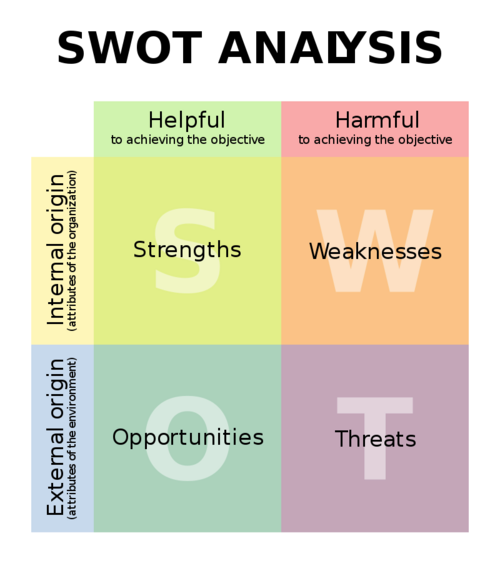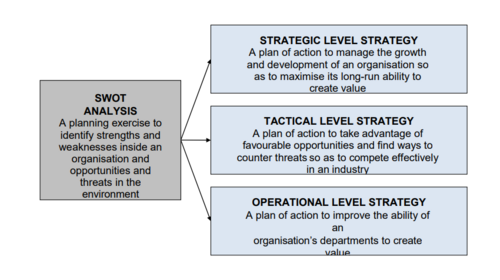Implementing SWOT
Contents |
Abstract
This article is going to have focus on the SWOT Analysis. There will be an introduction to the SWOT and how to implement the tool. Furthermore, there will be a focus on the strenghts and weaknesses of the SWOT analysis which is something that is very beneficial and relevant when working with this tool. In relation to project management, the SWOT analysis can be applied in several different fields like research, strategy or marketing in both public and private organizations and companies.
Many companies apply SWOT to get an overview of the potential risks and the obstacles and difficulties there can be. The aforementioned can be for both internal and external problems and purposes. The abbreviation, SWOT, derives from Strengths, Weaknesses, Opportunities and Threats. So the main purpose of the SWOT is to be an analytical device for defining the four aforementioned factors in a specific organization or establishment.
Both the Weaknesses and strenghs can be viewed as internal factors which could be something like ressources or skills that the company possesses. Oppurtunities and threats are viewed as external factors where the company or organization's influence is mainly indirect, which is a correlation to it being called "external" factors or conditions.
Overall, SWOT is designed to give a fact-based and realistic look into an organization, project or any other initiative that is being set in motion. The result may not be a definite action plan but is a very good benchmark and indicator which can give a good point of orientation.
If the SWOT is used well and with a relatively broad base of both external and also internal input, it will lead to a strong analysis that qualifies and enhances the potential for all or parts of a an organizations projects or other initiatives.
Introduction of the SWOT
Implementation of the SWOT
Strength
Strenghs of the company refers typically to the internal skills and resources.It can also be defined as the key factors which plays a role in the company doing well. Examples of strengths could be: trusted brand, high quality, great communication and a good location.
Key questions for the organization to go through it, is by asking questions like:
- What is the things we are very good at, which is better than others? - what is the specific competencies that leads to our success? - What cooperations and relationships do we have with others?
Weakness
You can say weakness is when an element in the strength tends to fail. In other words, the weakness can be seen as a barrier for the organization to achieve its business goals and objectives. Examples of weaknesses in an organization could be: Bad reputation, poor communication, inexperienced in the field or poor quality.
Key questions for the organization to go through its weaknesses, is by asking questions like:
- what is something we are not good at in the company? - what kinds of cooperations and alliances should we have (but dont have)? - does our workforce lack anything when it comes to training or competencies?
Opportunity
Opportunity is an external factor which is something the company can control. The opportunity factor is something which has an effect on future developments and possibilities. So overall, this factor enables the company to enhance its growth and business. Examples of weaknesses in an organization could be: launch a new product, Outsourcing, extending to new markets or outlets.
Key questions for the organization to go through its opportunities, is by asking questions like:
- What kinds of outlets or markets might open its doors to us? - What new technology could be useful and something to invest in? - What kinds of weak points and elements does our competitors have, which we can take advantage of and exploit? - what could be some adaptments that we need to make to catch up with the external enviroment?
Threats
Threats are also external factors like opportunities. Threats are factors which can be harmful and be the cause and risk for the organization not achieving its main goals and objectives. As it is an external factor, it is not something which can be controlled by the organization itself even though it can have a massive effect and crucial impact on the organization. Examples of threats in an organization can be: habits of customers is changing, emergence of a new and different product or the competitors getting more popular in the relevant market.
Key questions for the organization to go through its threats, is by asking questions like:
- How can changes in society or customer needs, hurt us? - How can new taxation policies or legislations effect us? - Are we dependent on something external which could damage us if it collapses?
How to implement the SWOT
Even though the SWOT seems to be a very straightforward and simple tool, it is a very useful and efficient method when looking at the business side of it. When implementing the SWOT tool, the company needs to put some effort, time and resources. The implementation of the SWOT analysis is not a one-man job, rather it is something which needs focus from a whole team which dedicates its time to it. One of its benefits is that it is not complicated and uncomprehensive, rather it is something which is manageable and straighforward which makes the whole procedure very feasible and practicable.
The process itself can be done in an easy way and a comprehensible order. Doing it by a step-by-step method makes it more convenient and clear. A guide for conducting it is seen underneath:

